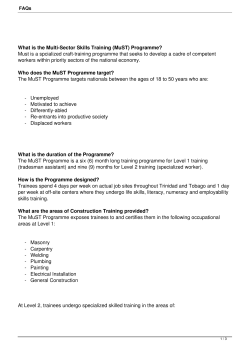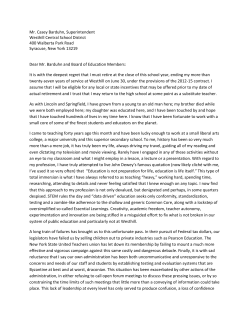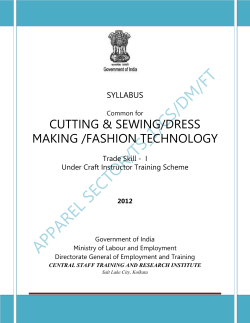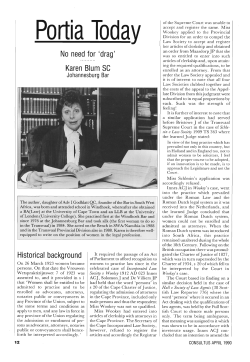
Document 245568
Pertanika 13(2), 275-282 (1990)
Why They Choose Teaching: a Factor Analysis of Motives
of Malaysian Teacher Trainees
NORAN FAUZIAH YAAKUB
Depmtment of Education
Faculty of Educational Studies
Universiti Pertanian Malaysia
43400 UPM Serdang, Selangor Dm'lll Ehsan, Malaysia
Key words: motives, Malaysian, teacher trainess, teaching profession, factor analysis.
ABSTRAK
Satu kajian telah dijalankan he atas 210 mung guru pelatih semester heempat yang mengkhusus dalam
pengajaran sellOlah ,"endah dar; sebuah mahtab pergu''llan di Kuala Lumpur bag; tahun pengajian 1986/
87, untu/! mengenalpasti motif mengajar di halangan mereka. Keputusan dmipada analisis faktor
menghasilkan ena11/. faktor, tetapi hanya lima daripadanya ditafsirlwn. Faktor 1 menyentuh tentang
pe1timbangan peribadi sebab memilih pergurnan; Fahtor 2 11te1'1-)'entuh tentang nilai mengajar; Faktor 3 hal·
hal yang bm;fat all''ll;st;k; Faktor 4 merujuk kepada headaan peherjaan yang d;senang;; m,mahala Faktor
5 berhait dengan penganth daripada orang utama. &jJU.tusan lcajian dibincangkan dan segi teori pemilihan
pekerjaaan Gim:.berg dan lain-lain karya bertalis yang berhaitan. Keputusan kajian ini mempunyai beberapa
implilwsi kepada pemihhan guru-guru pelatih.
ABSTRACT
A study was canied out on 210 fourlh semester teacher trainees specializing in primary school teaching franz
a teachers' college in Kuala Lumpur fOT the 1986/87 academic year, to seek out their motives for taking up
teaching. Results offactor analysis produced six factors, five of which were inttnpreted. Factor 1 touches on
personal considerations for teaching; Factor 2 on the values of teaching; Factor 3 is altnListie in nature;
Factor 4 1'efe1'S to agreeable working conditions and Factor 5, influence 'received from key persons. Results are
discussed in relation to Ginloberg's themy of occupational choice and other 'related literature. The findings of
the study have several implications on the selection of teacher tminees.
INTRODUCTION
Investigations on the motives for taking up the
teaching profession have been going on for
more than half a century, mainly outside
Malaysia. These studies report on the motives
of either teachel- education students (Fox 1961;
Richards 1960; Haubrich 1960; Saxe 1969; Ee
1974; Anucia 19SI;jantzen 19S1). or qualified
teachers already serving in the schools (Obura
1974; Lortie 1975; Goodlad 19S4).
\¥hen recruiting students into a teacher
education programme. it is pertinent to find
anS\·vers to tWO important questions. First, what
inspired these young people to enter the
Key to author's l\ame: Noran, F.Y.
teaching profession? Second. are the reasons
given by them enough to suggest that they will
be good teachers?
The purpose of this paper is to identify
the motives for taking up teaching among
teacher trainees in a Malaysian teachers'
u-aining college.
MATERIALS AND METHODS
Subjects
Subjects for this study were 210 primal)' school
teacher trainees from a Kuala Lumpur teachers' college. The trainees were in the fourth
(July) semester of their programme during the
ORA, FAUZIAH YAAKUB
1986/87 academic year. The sample comprised
113 males and 97 females from the three major
ethnic groups, viz., Malays, Chinese and
Indians.
Instrumentation
Thirty items were specially developed by the
reseacher to extract the underlying motives for
teaching. The items came from two sources.
The first group of items came from the results
of a pilot study carried out on two groups of
teacher trainees from me Language Institute,
Kuala Lumpur, to seek out their reasons for
joining teaching. The responses obtained were
then compared to the questionnaire used by
the Singapore Research Unit (1969). Twenty
of the motives obtained from the pilot study
were found to be similar to those items in the
SRU Questionnaire. Two other items were
dissimilar to the Singapore version but were
nevertheless included. The second source,
involving eight items, was Fox's (1961)
questionnaire.
For each item, four alternative responses
were given, Le., "strongly agree" (SA), "agree"
(A), "disagree" (D) and "strongly disagree"
(SD). Respondents were required to indicate
their answers on the same questionnaire by
circling the relevant coded numbers provided
in the ';ght-hand margin. The completed
questionnaires were edited and the data
transfered on to diskettes by the author. Data
processing was carried out on the IBM 4381
mainframe at the Universiti Sains Malaysia
using the SPSS programme.
Analytical Procedure
The 30 items measuring motives for teaching
were subjected to factor analysis which reduced
the number of variables into just a few motive
factors. Principal factoring with iteration was
the type of factor analysis employed. Six factors
were specified to be extracted based on the
literature review. Varimax rotation was used on
the asumption that there was very little
correlation beaveen the factors.
The 30 items were factor-analyzed for the
follov{ing reasons. First, it is desirable to
determine how many latent factors there are
underlying the set of the 30 items or variables.
276
Second, based on the number of factors
derived and the items included in each factor,
one is then able to interpret the factors. Third,
with. factor analysis one is able to find out the
amount of each common factor possessed by
each observation i.e., the factor scores.
Results
The results of the factor analysis of the 30
items, using the varimax principal factor rotation, produced six factors. However, following
GhazaJi (1979), only loadings of more than 0.3
were considered. Thus, only five factors, accounting for 93.8 percent of the total factor
variance, were interpreted. The loadings of the
28 i terns on these five factors are given in
Table 1. For convenience, the i-th factor will
be abbreviated as FAGi; thus the first factor is
written as FAG!, the second factor FAG2, and
so On.
Relative frequencies of responses to the 30
items are given in Tables 2 through 7. The
items are classified according to the factors
extracted. Thus QM3 refers to question 3 of
the questionnaire. and so on. Unclassified
items are given in Table 7.
Items for FAGI touch upon the individnal
making the decision to become a teacher.
These items refer to how the individual appraises his inner qualities. Thus, FACl may be
interpreted as representing the "personal consideration" dimension. FAC2 accounts for the
similarity among items relating to factors apart
from the self. Le., looking at external reasons
allached to the job. FAG2 may be termed the
"teaching values" dimension. Items for FAC3
touch on idealistic reasons related to teaching;
and this Factor may be called the "altruistic"
dimension. FAC4 refers to "agreeable working
conditions" dimension. FAC5 may be
interpreted as representing the "influence
received" dimension.
Factors Intl!1preted from. the Varimax Factor Matrix
FAC!. After the orthogonal rotation, eight
items are found to have high factor loadings
on the first factor. The eight items relate to
the evaluation of one's personal likings and
ability. Six items have positive loadings while
the remaining two loadings are negative in
PERTA lKA VOL. 13 TO. 2. 1990
A FACTOR ANALYSIS OF MOTIVES OF MAlAYSIAN TEACHER TRAINEES
TABLE I
Varimax rotation of factor matrix for motive variables
Variable
FACI
QM3
QM6
QM8
QM9
QMII
QMI3
QMI4
QMI8
QM4
QMI5
QMI7
QM23
QM28
QM29
QM30
QMI
QM7
QMI2
QM22
QM25
QMIO
QMI6
QMI9
QM20
QM26
QM2
QM5
QM27
-.457
.592
.624
Percent of
variance
FAC2
FAC3
FAC4
FAC5
Communality
.616
.687
.392
.459
.386
.546
.399
.446
.298
.181
.508
.460
.145
.254
.451
.425
298
.357
.247
.128
.489
.340
.436
.299
.257
.571
.361
.310
.399
.547
.184
7.8
93.8
.596
.638
-.451
.345
.585
.660
.326
.386
.513
.457
.483
.559
.328
.314
.692
.418
.433
.373
.304
.721
.544
.415
39.1
25.5
12.0
9.4
Note: Factor loadings of less than 0.3 are ignored; five factors were extracted tor interpretation; QM21 and QM24 dropped
out.
nature.
In order of magnitude of the factor
loadings, the firsl item (QMl1) touches on the
suitability of teaching in relation to one's
ability and character. The second item hinges
on liking for teaching itself (QMB), followed
by the third item which is a liking for children
(QM9). The fourth item states that teaching
is fun (QM4), while the fifth item says that
teaching has been one's ambition for a long
lime. Item six is a statement on leaching as a
noble profession. Items 7 and 8 are negative
in nature but they are related to questions
relating to the self. Item seven (QM3) states
that one joins teaching as a last resort, while
item eight (QM13) refers to the reason for
joining teaching as a stepping stone to another
profession. Thus, Factor 1 may be labelled as
personal considerations. (Table 2.)
FAC2. A second set of items refers to some
teaching values given to teaching (Table 3). The
motives for this Factor, according to rank, are
job security (QM4), ease of getting employment after graduation (QM30j, to
overcome the teacher shortage in the country
PERTANlKA VOL. 13 NO.2. 1990
277
NORAN FAUZIAH YAAKUB
TABLE 2
Relative frequency of responses to items under personal considerations (FACt)
Item
SD
-
QM3.
QM6.
QM8.
QM9.
QMII.
QMI3.
QMI4.
QMI8.
I have no other choice
Teaching is interesting
I like tcaching
I like children
My character and ability al"e suited to teaching
Teaching is a stepping stone to another profession
Teaching ia a noble profession
Teaching is my ambition
A
D
Percent -
39.0
1.4
41.4
0.5
8.7
9.2
17.4
49.3
1.9
23.8
0.5
1.4
29.0
0.5
5.7
SA
26.0
13.3
63.9
76.0
59.9
64.3
17.9
35.3
45.7
6.2
8.7
14.9
30.4
16.9
3.9
62.3
24.8
A
SA
TABLE 3
Relative frequency of responses to items under teaching values (FAC2)
Item
SD
D
QM4.
QMI5.
QMI7
QM23.
QM28.
QM29.
QM30.
Teaching is a secured job
Teaching gives me the opportunity to further my studies
Teaching will put me in a respectable place in society
I feel I can help overcome teacher shortage in Malaysia
I am unhappy about the performance of poor teachers
I like a cerlain school subject
It is easy to get employment after my teacher training
1.4
0.5
7.2
1.0
8.1
8. I
8.1
Percent -
10.0
9.6
32.2
12.9
15.3
32.4
21.0
56.9
52.9
49.5
67.1
57.4
46.2
52.9
31.1
37.0
11.1
19.0
19.1
13.3
18.1
A
SA
TABLE 4
Relative frequency of responses to items under altruistic reason (FAC3)
SD
Item
D
-
QMI.
QM7.
QM12.
QM22.
QM25.
Teaching gives me the opportunity to be of
service to society
1.0
Teaching gives me the opportunity to realise my potential
in management, leadership, speak in front of others, etc. 0.0
Teaching is challenging
0.5
I feel I can educate the younger generation
0.0
I want to impart knowledge to others
1.0
(QM23), liking for a particular school subject
(QM29), dissatisfaction with performance of
poor teachers (QM28), social prestige
bestowed upon teachers (QMI7), and
opportunity for further studies (QMI5).
278
Percent -
1.4
50.0
47.6
4.3
8.2
2.9
2.4
48.6
52.4
78.1
67.1
47.1
38.9
19.0
29.5
FAC3. A third set of items refers to some
idealistic aspect related to teaching. This factor
may be called altruistic reasons (Table 4), and
may be regarded as an important factor
influencing one's decision to take up teaching.
P£RTANIKA VOL. 13 NO.2, 1990
A FACfOR ANAL\'SlS OF MOTrvES OF MAlAWIAJ'J TEACHER TRAINEES
TABLE 5
Relative frequency of responses to itcms under agreeable working canditions (FAC4)
SD
hem
D
QMlO.
QM16.
QM 19.
QM20.
QM26.
Teaching is an easy job after marriage
I was influenced by my parents
Thcre is a lot of holidays in teaching
Teacher's working hours are shan
My SPM/STPM results are approprite to become
a teacher
A
SA
-
Percent
14.5
38.5
2.9
17.2
44.9
41.8
37.0
565
30.4
12.5
49.5
22.0
10.1
7.2
10.6
4.3
2.9
23.3
59.0
14.8
A
SA
TABLE 6
Relative frequency of responses of items under influence received (FAC5)
SD
Item
D
QM2.
QM5.
QM27.
I was influenced by other students who want to be
teachers
I was influenced by my tcachers
1 was advised by my guidance teacher
41.4
31.1
38.6
-
Percent
48.6
43.5
38.1
7.6
23.4
21.9
1.4
1.9
1.4
A
SA
TABLE 7
Relative frequency of responses to items under "unclassified items"
SD
Item
D
QM21.
QM24.
Teachers are well paid
I am unable to pursue my studies in the university
High on the list is the value attached to
teaching as a challenging job (QM12),
followed by the desire to impart knowledge
(QM25), the desire to educate the younger
generation (QM22), the opportunity to render
service to society (QM1), and the opportunity
to prove one's capability in handling group
situations (QM7). Ringness (1952) calls this
factor "self-esteem". Fox (1961) labels an
almost similar sel of items "altruistic reasons",
FAG4. A fourth set of items may be termed
interest in agreeable wm*ing conditions (Table 5).
Long vacations as a fringe benefit to teaching
(QM1 9), relatively short working hours (QM-
30.0
26.7
Percent -
595
38.1
9.5
21.9
1.0
1.4
20), relevant academic qualifications (QM26),
convenient job after marriage (QMlO) , and
family influence (QM16) are highly loaded on
this factor. Ringness (1952) labels an almost
similar factor as "interest in working
conditions". Fox (1961) refers to these as
"practical reasons."
FAG5. The fifth set of items may be termed
"influence received" (Table 6). This is reflected
in the statements of influence of former
teachers (QM5), influence from peers who
want to become teachers (QM2) , and aclvice
from career guidance teachers (QM27).
Since factor loadings of 0.3 and below are
PERTANIKA VOL. 13 NO.2, 1990
279
NORAN FAUZlAH YAAKUB
ignored, two items were dropped. These are
item QM21 ("teachers are well paid") and item
QM24 ("1 am unable to pursue my studies at
the university") (Table 7).
DISCUSSION
Normally, the first thing that one would
consider when making an occupational choice
is to analyze oneself in terms of capabilities,
interests and personal values related to the
occupation. Results from the factor analysis
seem to lend credence to the theory of
occupational choice proposed by Ginzberg et
al. (1951). The first category in occupational
choice is labelled as the self factor, which is
similar to the personal considerations factor
in this study.
It is generally agreed that one of the
personal attributes expected of teachers
(especially at the primary school level) is
"liking for children". About 90 percent of the
respondents indicate they like children. This
motive seems to be popular as shown in the
literature (Best 1948; TUdhope 1944; Haubrich
1960; Ee 1974; Lortie 1975; Jantzen 1981;
Wood 1978; Book, Freeman and Brousseau
1986).
Teaching is a profession which provides
teachers with ample opportunities to interact
with children; such opportunities enable the
teachers to acquire a better understanding of
their young "clients", Thus, it is desirable that
those who decide on a teaching career have a
genuine liking for children. There has been
several calls from teacher organizations in the
country on the need to select potential
teachers on the basis of their "positive attitude
towards teaching," a term which may be safely
interpreted as "liking for children",
The second category proposed by Ginzberg et al. deals with the influence of the
individual's perception of the real world on
his or her choice of occupation. This category
is labelled as the reality factor. The three
extracted factors of FAC2 (values towards
teaching), FAC3 (altrustic factor) and FAC4
(agreeable working conditions) may all be
classified under Ginzberg's second category of
occupational choice.
In a country such as Malaysia, where the
280
teaching personnel of primary schools are nonuniversity graduates, it is natural to see a great
majority of college teacher trainees expressing
a desire of furthering their education at the
university (Ee 1974; Anucia 1981). Most people
perceive a university education to be a passport
for upward social mobility, enabling the former
non-university graduates to move up the social
ladder, either within the teaching profession
itself or outside the profession, such as
business, public administration and politics.
It is also commonly acknowledged that
securing a job after completion of a teacher
education programme at anyone of the 28
colleges in Malaysia is almost assured. This is
because all teacher trainees are sponsored by
the MiniSH)' of Education to meet manpower
needs of the Ministry. Currently, their
prospects for employment seem to be brighter
than those of university graduates, including
government scholarship holders, who find it
increasingly difficult to secure employment
immediately after graduation. Furthermore.
school teaching, like other government service
occupations, is considered to provide
maximum job security, in the sense that
termination of service or retrenchment is rare.
Agreeable working conditions, such as
short working hours and long vacations, are
another reality factor associated with teaching
(Goodlad 1984; Rowsey and Ley 1986). These
practical considerations seem to be weighed
more heavily by women lhan men. and these
considerations may have influenced women to
decide to become teachers earlier than men
(Saxe 1969; Jantzen 1981; Best 1948).
Altruistic reason is another reality factor
frequently quoted by potential teachers. The
findings of this slUdy indicate lilat teacher
trainees are indeed altruistic in their motive
for teaching, and this conclusion is
corroborated by research reports of other
investigators.
There are several ways of expressing the
altruistic motive. Teaching gives the
opportunity to impart knowledge (Fox 1961),
or to educate the younger generation (Anucia
1981). A desire to help or be of service to
others still ranked highest among Joseph and
Green's (1986) respondents. There are
PERTANII(A VOL. 13 0.2. 199u
A FACTOR ANALYSIS OF 1IOTIVES OF \WA'rSIAN TEACHER TRAINEES
teachers who say that they get personal
satisfaction from teaching (Book el al. 1985;
Rowsey and Ley 1986).
Joseph and Green discussed the issue of
altruism in contemporary society. According to
these investigators, people who choose
teaching in spite of the lower prestige of the
profession in modern society are willing 10 get
lower financial remuneration. Their motives
for teaching are more altruistic in nature than
materialistic. Mclaughlin et at. (cited by Joseph
and Crccn, 1986) had compared teaching to
a religious vocation. According to McLaughlin,
people who choose teaching are supposed to
have "saintly" qualities because they would
settle for a career with few material benefits,
yet not highly respected by the public or one's
own family.
Cinzberg's third category of reasons for
occupational choice is called hey persons who
influence one's decision to take up an
occupation. These key persons may be former
teachers, own paren ts, or friends. The fifth
b.ctor extracted from the factor analysis did
indicate a slight influence from peers and
former teachers (Table 6). In the light of this
finding, a few questions may be posed for
consideration. If teacher trainees indicate they
received very little influence from their former
teachers, why is this so? Are teachers, especially
guidance tcachers, not recommending
teaching to their pupils? Or, have the teachers
themselves lost enthusiasm in teaching, for
various reasons, that they avoid advising pupils
on the prospects of teaching?
CONCLUSION
The findings of this study have implications
on the selection of teachers. Based on the
different responses given by prospective
teachers on their motives for teaching, one
implication is that selection committees need
to be cautious in the selection and recruitment
of teachers. This suggests that there is a need
for selection committees to be sensitive to the
different motives of their candidates. For
example, altruistic motives should not be taken
at their face value because these could be
learned responses.
From the findings of the sLUdy, it is
proposed that a standardised instrument be
developed by selection committees to be administered on prospective teachers, seeking
their reasons for choosing teaching. Using
proper tools in the recruitment of teachers is
just one of the methods of ensuring effectiveness among teachers.
Further studies are needed on the motives
of a cross-section of teacher trainees in the
country. In view of the current shortage of
teachers, a knowledge of the different underlying motives for teaching would give further
insights into this problem. In addition, a
comparison between motives of college teacher
trainees and university pre-service education
students would further eluich our knowledge
in this sphere.
ACKNOWLEDGEMENTS
The author wishes to gratefully acknowledge
the advice rendered by Dr. Chazali Othman
of University Sains Malaysia; and the
permission to conduct this study, by the
Educational Planning and Research Division
(EPRD) , Malaysiau Miuistry of Education.
REFERENCES
ANUCIA, MUTHUCU~IARl. 1981. Motivational Patterns
of Teacher Trainees and Their Relationship to
Teaching Performance in the Classroom. M.
Ed. Dissertation, University of Malaya.
BEST, J. W. 1948. A Study of Certain Selected Factors
Underlying (he Choice of Teaching as a Profession. j. E.<p Ed. 17: 201-159.
BOOK, C. L., DJ. F..Ht-\N and B. BROUSSEAU. 1985.
Comparing Academic Backgrounds and Career
Aspirations of Education and Non-Education
Majors. j. Teach Ed. 36(3): 27-30
EE, DAISY. 1974. A Study of the Factors Influencing
Teacher Trainees Choice of the Teaching Profession in West l\-'la1aysia. M. Ed. Thesis, University of Malaya.
Fox,
R·\\~IONn, B. 1961. Factors Influencing the
Career Choice of Prospecti\'e Teachers. J. Teach
Ed. 12(4): 427-432.
1979. An Investigation of the
Sources of Job Satisfaction of Malaysian School
Teachers. Ph. D. Dissertation, Uni\'crsit), of
California, Los Angeles.
GHAl-\U BIN OTHMAN.
GrNzBERG,
E.,
PERTANIKA VOL. 1~ NO.2, 1990
S.\rV. GINZBlo:RG, S. AxELRAD
and
J.L.
281
NORAN FAUZlAH YAAKUB
HER.MA. 1951. Occupational Choice: An Approach
to a General TheOlY. New York: Columbia Univ.
Press.
GoODLAD, J. I. 1984. A Place Cali£d SdlOol: Prospects
for the Future, New York: McGraw-Hill.
HAUBRICH, V.F. 1960. The Motives of Prospective
Teachers. J Teach Ed. 11: 381-386.
J. MARC. 1981. Why College Students
Choose to Teach: A Longirudinal Study. J Teach
Ed. 32: 45-48.
JA.NTZEN,
JOSEPH, P.8. and NANCY GREEN. 1986. Perspectives
on Reasons for Becoming Teachers. J Teach Ed.
37(6): 28-33.
LORTIE, DAN, C. 1975. Schoolteacher, A Sociological
Study. Chicago: The University of Chicago Press.
OBURA, SIMON OJUANGA. 1974. Attitude Towards and
Toward Teaching, j. Teach Ed. 11: 375-380.
Relationships between
Certain Attitudes Towards Teaching and Teaching Success. j. Exp Ed. 21: 1-55.
RINGl'\'ESS, THOMAS, A. 1952.
R.E. and TERRY C. LEY. 1986. Perceptions
of Teachers' Salaries and Non-salary Benefits.
j. Teach Ed. 37(2): 42-45.
ROWSEY,
SAXE, R. W. 1969. Motivation for Teaching. Teachers
Call Rec. 70: 313-319.
SINGAPORE REsEARCH UNIT. 1969. Why Teach?: A
Study of Motives For Choosing Teaching As A
Career. The Singapore Teacher's Training
College, Singapore.
TUDJ-IOPE, W. B. 1944. Motives for the Choice of
the Teaching Profession by Training College
Students. Bnl. j. Ed. Psychol. 14: 129-141.
Interest in Teaching among Trained School
Teachers. M. Ed. Dissenation, University of
Malaya.
WOOD, KARLYN, E. 1978. Whal Motivates Students
to Teach' j. Teach Ed. 29(6): 48-50.
RICHARDS, R. 1960. Prospective SlUdents' Attitudes
(Received 28 jn"e, 1988)
282
PERTANIKA VOL. 13 NO.2, 1990
© Copyright 2025











